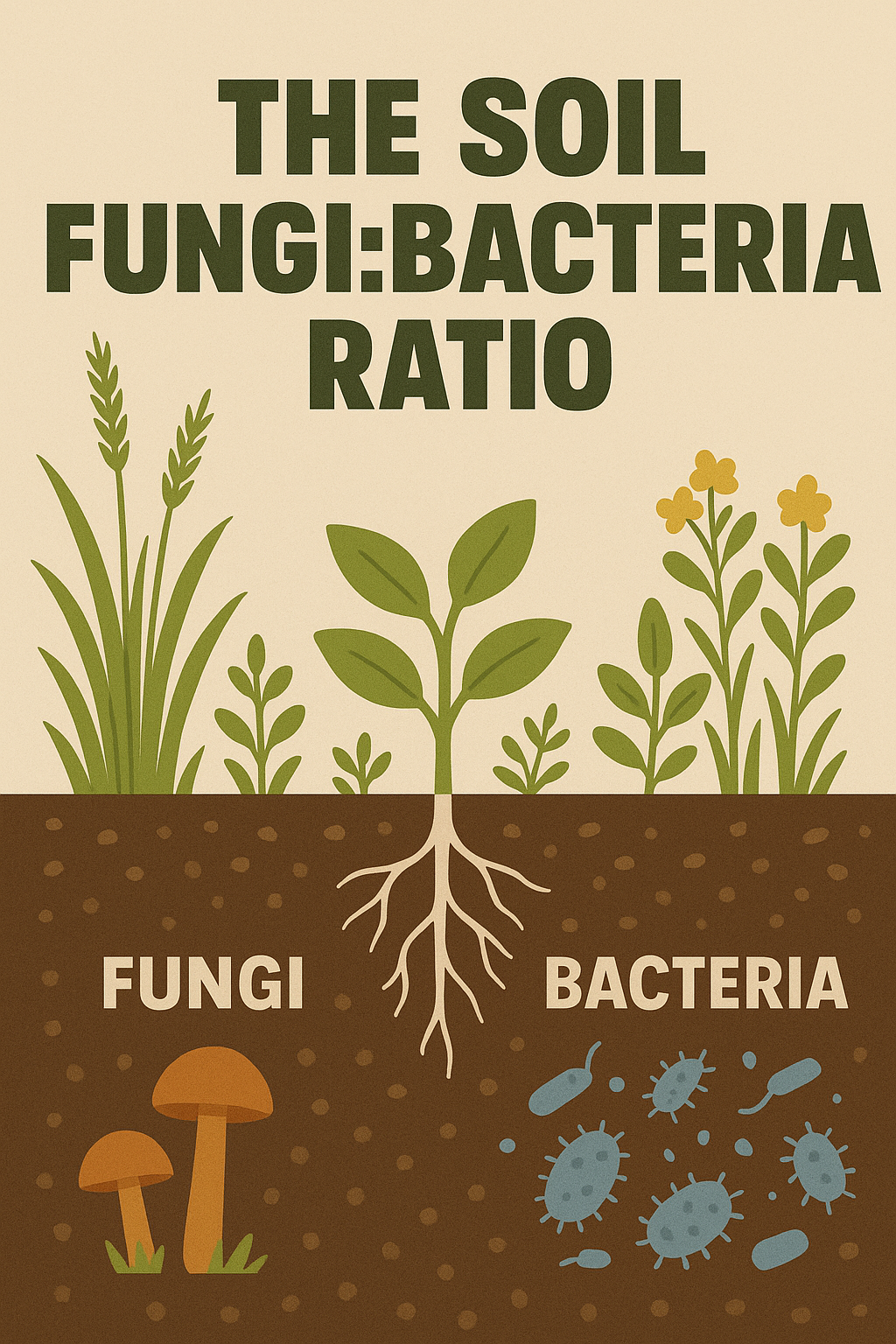
The Soil Fungi:Bacteria Ratio
How Root Exudates and Soil Additives Influence Microbial Balance
Soil is not just dirt - it's a living, breathing ecosystem, and at the heart of it is the microbial community. Two dominant microbial groups - fungi and bacteria - play crucial roles in nutrient cycling, plant health, and soil structure. The fungi:bacteria ratio (F:B ratio) is a key indicator of soil function and health. Understanding and managing this ratio can help farmers promote healthier, more resilient soils.
Why the Fungi:Bacteria Ratio Matters
The F:B ratio reflects the balance between fungal and bacterial biomass in the soil.
- Bacteria dominate in disturbed, tilled, or heavily fertilised soils. They thrive on simple sugars and rapidly decompose green plant material.
-
Fungi, especially arbuscular mycorrhizal fungi (AMF), prefer more stable environments with less physical disruption. They break down more complex organic matter and form symbiotic relationships with plant roots.
A balanced or fungi-dominant soil is often associated with:
- Higher carbon sequestration
- Better soil aggregation and structure
-
Greater nutrient efficiency and drought resilience
Pasture systems typically benefit from a balanced F:B ratio, while forest soils are often fungi-dominant, and heavily fertilised crop soils are often bacteria-dominant.
The Role of Root Exudates
Plant roots exude a diverse array of organic compounds - called root exudates - including sugars, amino acids, organic acids, and secondary metabolites. These exudates feed soil microbes and shape the microbial community around the root zone (rhizosphere).
- Plants in fungi-favouring systems (e.g., perennial grasses, shrubs, trees) release more complex exudates, which support fungal growth
-
Annual crops and legumes release more simple carbohydrates that favour bacterial populations.
Thus, plant species selection and management practices that reduce stress influence the F:B ratio through their effect on root exudation.
Additives and Practices That Increase Soil Fungi
To promote fungal populations in soil, consider the following practices and amendments:
1. Compost (fungal-dominated)
Fungal-rich composts (made with woody materials and cured over a longer period) can introduce beneficial fungi like Trichoderma and AMF.
2. Biochar
Biochar provides habitat for fungi and helps reduce bacterial overgrowth in highly disturbed or nitrogen-rich soils. It also buffers pH and improves moisture retention.
3. Reduced Tillage
Frequent tillage breaks up hyphal networks and destroys fungal habitat.
4. Cover Cropping with Perennials and Grasses
Long-rooted, perennial plants maintain stable fungal associations and reduce bacterial dominance.
5. Humic Substances (Humates)
Humic acids and fulvic acids - commonly derived from leonardite or composted organic matter - stimulate fungal growth, enhance root development, and improve nutrient chelation. They provide a carbon-rich food source for soil fungi and help buffer pH.
They also improve cation exchange capacity (CEC), reduce nutrient leaching, and support the establishment of beneficial fungi like arbuscular mycorrhizae.
6. Seaweed Extracts
Seaweed-based biostimulants contain natural hormones, amino acids, polysaccharides, and micronutrients that can improve soil structure, microbial diversity, and nutrient cycling. While studies report varying results depending on formulation and soil conditions, most show positive effects on microbial activity and resilience.
Seaweed doesn’t directly feed fungi the way humates do, but it supports a healthier, more balanced soil food web, particularly when used in tandem with composts or diverse cover crops.
What Prevents Bacterial Overgrowth?
To avoid bacterial dominance, which can lead to nitrogen losses and poor soil aggregation:
- Avoid overapplication of synthetic nitrogen: High-N inputs favour fast-growing bacteria and suppress fungi.
- Minimise tillage and compaction: These destroy fungal hyphae and favour opportunistic bacteria.
- Balance C:N ratio in organic inputs: Use inputs like straw, bark, or woodchips that favour fungi over bacteria.
- Avoid simple sugar additives unless combined with fungal stimulants.
Summary Table
|
Strategy |
Effect on Fungi:Bacteria Ratio |
|
High-N Fertiliser |
↓ Fungi, ↑ Bacteria |
|
No-till / Strip-till |
↑ Fungi |
|
Fungal Compost |
↑ Fungi |
|
Biochar |
↑ Fungi |
|
Deep Rooted Species |
↑ Fungi |
|
Simple Sugars e.g. Molasses |
↑ Bacteria |
|
Seaweed |
May feed both but results from various studies seem to be positive |
|
Humates |
↑ Fungi |
Are Annuals Still Valuable in Regenerative Systems?
Yes - despite their tendency to favour bacteria via simple root exudates, annual species still play an important role in regenerative agriculture.
- Rapid biomass and root growth: Annuals grow quickly and release high levels of simple sugars into the soil, stimulating microbial activity and improving soil structure.
- Nutrient scavenging: Deep-rooted annuals like daikon radish and annual ryegrass are effective at capturing nutrients such as nitrogen before they leach, then releasing them back into the soil through decomposition.
- Ecological succession: Annuals act as pioneer species, helping to build soil biology and structure in degraded or compacted areas, paving the way for fungal-dominant, perennial systems.
- Weed and pest disruption: Certain annuals can suppress weeds and interrupt pest life cycles while supporting beneficial microbial populations.
- When used strategically in seed mixes or rotations, annuals complement perennials, providing short-term soil function and preparing the ground for long-term improvement.
Final Thoughts
Managing the fungi:bacteria ratio is not about eliminating bacteria - it’s about restoring functional balance. A more fungal-dominant soil is often more stable, carbon-rich, and symbiotic. For farmers focused on long-term productivity, nutrient efficiency, and soil resilience, shifting the F:B ratio through smart plant selection and targeted soil inputs is a high-leverage move.
